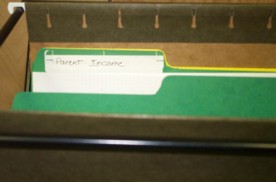 |
The Learning Ladder II
|
| Module 6: Family Child Care as a Business | ||||
| Part 1 | Part 2 | Part 3 | Part 4 | Part 5 |
Record Keeping and Taxes
 As a family child care provider, you are not only providing a very valuable
service to families, but you are also running a business. You need to keep
accurate records of your income and your expenses and you must file for
income taxes each year. Keeping complete and accurate records will help
you to reduce your taxes and increase your profits.
As a family child care provider, you are not only providing a very valuable
service to families, but you are also running a business. You need to keep
accurate records of your income and your expenses and you must file for
income taxes each year. Keeping complete and accurate records will help
you to reduce your taxes and increase your profits.
Some providers open up a business checking account to deposit day care income and to write checks for expenses. Cancelled checks and expense receipts should support each other.
What records should you keep?
There are two types of records that you will need to document for your family child care business. One type of record keeps track of income. Income includes:
- Fees received from parents. You might want to give a receipt to each parent and keep a copy for yourself. For tax purposes, copies should be kept for up to three years
- Money from the Child Care Food Program should be listed as "other income" for easy identification. You should also keep separate receipts for your food purchases for your family child care business. This includes: grocery receipts, copies of menus, and children's attendance records.
- Government Subsidies: this includes moneys that pay for children's care (such as vouchers, CPC slots) and grants that you receive to improve your home or purchase equipment.
Expenses are the second type of record that you will want to track carefully. Expenses are also broken down into full deductions and partial deductions:
- Full Deductions: Keep track of the following expenses and be sure to get separate receipts. These are fully deductible. Record all money spent for food; household daycare supplies such as crayons, markers, paint, books and tapes. You can also deduct gifts (such as birthday gifts) to children. Record all education expenses such as admission costs for field trips; memberships and subscriptions to child care organizations; and training costs. You can also deduct the following expenses fully for taxes: file folders, expense of making copies, postage, insurance, advertising, legal and accounting fees.
- Partial deductions: some items such as cribs, car seats and swing sets can be depreciated over seven years. Check with the IRS tax codes so that you know the rate of deductions for these items.
The biggest partially deductible expense is the use of your family home in the business.
| Finished the reading? Go to the activities for Part 3. | |
